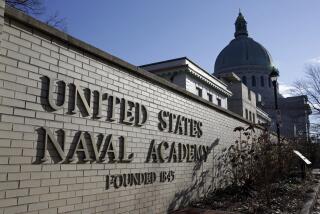Military’s Medical School Hangs On Despite High Cost : Pentagon’s $462,513 per student is about four times the cost of private training.
- Share via
How much money does it take to train a physician in America? About $115,000 over four years, if the candidate attends one of the nation’s 126 private medical schools. Or $462,513 if he--or she--goes to the medical school that is run by the Pentagon.
At a time when there is no shortage of doctors--and when the federal government is desperate to save money anywhere it can--you would think that such excessive costs would make the military medical school a prime target for congressional budget cutters. Indeed, the Uniformed Services University of the Health Sciences in Bethesda, Md., for a time was slated to be closed.
Over the past several years, the $72-million-a-year medical complex, created in 1972 ostensibly to provide physicians for the various armed services, has proved to be a nightmare of bureaucracy and cost overruns.
A study by the Pentagon disclosed “a host of unacceptable personnel and managerial practices” involving affirmative action problems and nepotism. A House subcommittee, angry over apparent abuses in an AIDS program, attempted to phase out the school by 1995.
But the university once again has been given a congressional reprieve and may be on the way to becoming Washington’s most visible textbook example of a federal boondoggle that no one can eliminate.
“All of the evidence indicates that the university is fundamentally more expensive . . . and that (the Pentagon) has not been able to provide any compelling reason to keep the school open,” says Rep. Martin Olav Sabo (D-Minn.), a member of the House defense appropriations panel.
Critics point out that, despite all the money that Congress has poured into the school, private medical colleges still are the Defense Department’s biggest source of military physicians.
The military medical school graduates 150 to 160 physicians a year. In contrast, last year a Pentagon-sponsored scholarship program at civilian schools provided more than 1,100 physicians to the military, and, with a companion program, it has 4,085 more in training. The cost: $114 million a year for both.
Defenders of the institution contend that the gap between per-student expenses for the military medical school and private medical schools may be less than published figures suggest.
In the first place, the figures covering private medical schools reflect only the tuition costs and do not include subsidies from other sources, including the federal government itself.
And they argue that the military medical school is the only medical school that provides training in the treatment of such specialties as chemical and biological warfare and on high-velocity missile injuries, combat stress and tropical medicine--all of which proved valuable in the Gulf War.
Even so, critics contend that the Pentagon’s competing scholarship program, which sends students to private medical colleges, manages to educate military physicians at a far lower cost than the military school and could provide specialized training under contract.
With the military campus, “all the costs are real and all the benefits are theoretical,” Sabo asserts.
But there is no secret why the Uniformed Services University has survived its first few years of operation. It was a favorite of the late F. Edward Hebert (D-La.), chairman of the House Armed Services Committee during most of the 1970s. And what Hebert wanted, Hebert generally got. In fact, the military medical school itself is named after Hebert now.
And Hill-watchers say that last year the university was saved from oblivion when advice columnist Ann Landers published a laudatory letter about the school, written by its own public relations officer.
According to congressional staffers, the Landers column engendered thousands of letters to lawmakers, who then pushed to reverse the subcommittee’s decision that would have phased out the institution.
In the meantime, the Pentagon has taken steps that it says are designed to cure the institution’s ills, placing it directly under Defense Department control (rather than under the aegis of a separate board) and reorganizing its personnel practices.
But the $462,513 cost per graduate remains unchanged.
More to Read
Sign up for Essential California
The most important California stories and recommendations in your inbox every morning.
You may occasionally receive promotional content from the Los Angeles Times.













